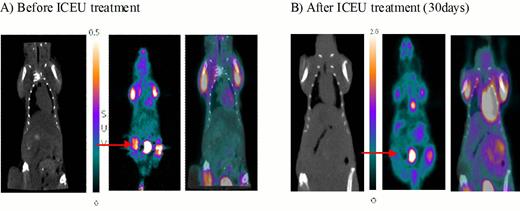Abstract
Mitochondrial aberrations have been associated with chronic degenerative diseases, aging and cancer. Mitochondrial proteins are interesting targets for the development of selective anticancer drugs in leukemia and other malignancies. We analyzed mitochondrial proteins to develop novel anti-cancer agents targeting selective leukemic cell, especially acute myelocytic leukemia (AML) cells.
Mitochondria were isolated from primary AML cells and AML cell lines (THP-1 and KG-1) by density-gradient ultracentrifugation using swelling buffer and sucrose buffer. Dysregulated mitochondrial protein were identified using 2-DE and mass spectrometry (MALDI-TOF/TOF technology). For in vivo experiments, AML cell grafts were established in 6-week-old Balb/c mice by subcutaneous injection of 1x107 THP-1 AML cells in the right flank at day 0.
Out of these deregulated proteins, totally 12 and 20 proteins were observed in up- or down-regulated spots, respectively. Interestingly, prohibitin (gi4505773) was highly expressed in all type of leukemic cells, especially primary AML cells (Fig. 1), which is confirmed by immunoblot and immunofluorecenct methods. Aberrant expressed prohibitin induced growth suppression and repressed E2F-mediated transcription. We synthesized potent chemical substances that can alkylate PHB, two molecules of phenyl-chloroethyl urea family such as cyclohexylphenyl-chloroethyl urea (CCEU) and iodophenyl-chloroethyl urea (ICEU) from the reaction with 2-ethylisocyanate and 4-cyclohexylaniline and 4-iodoaniline, respectively. They were characterized by 1H NMR and 13C NMR. Time and dose dependent manner of proliferation suppression when treated with CCEU and ICEU was observed in primary AML and AML cell lines. Notably morphological transformation of AML cells was observed when treated with 10 - 100 umol of CCEU and ICEU for 24 hours. The half maximal inhibitory concentration (IC50) was 25umol of most AML cell lines. Cell cycle analysis of CCEU-and-ICEU-treated- AML cells showed a remarkable increase of the sub-G1 phase. Immunoblotting experiment revealed the change of cytoplasmic and nucleoplasmic PHB. The increment expression of cleaved caspase3 and poly ADP-ribose polymerases were also observed in AML cell lines. Moreover, CCEU and ICEU selectively killed AML cells in mouse model (Fig. 2).
Aberrantly overexpressed mitochondrial prohibitin (PHB) in leukemic cells. Any type of primary leukemia cells and leukemia cell line showed to have highly expressed PHB in contrast to the expression of PHB in normal cell populations [peripheral blood cells (PB), peripheral blood stem cell (PBSCC) and cord blood cells (CB)].
Aberrantly overexpressed mitochondrial prohibitin (PHB) in leukemic cells. Any type of primary leukemia cells and leukemia cell line showed to have highly expressed PHB in contrast to the expression of PHB in normal cell populations [peripheral blood cells (PB), peripheral blood stem cell (PBSCC) and cord blood cells (CB)].
Micro-PET image of AML mass in mouse model. Xenografted AML cells as subcutaneous mass formation was noted in right thigh area (A) before treatment of PHB inhibitor. AML mass in mouse model was completely disappeared after treatment of PHB inhibitor for 30 days (B).
Micro-PET image of AML mass in mouse model. Xenografted AML cells as subcutaneous mass formation was noted in right thigh area (A) before treatment of PHB inhibitor. AML mass in mouse model was completely disappeared after treatment of PHB inhibitor for 30 days (B).
This study showed the development of novel alkylating chemotherapeutics, phenyl-chloroethyl urea family (CCEU and ICEU), targeting mitochondrial prohibitin for selective killing of leukemic cells. Selective eradication effects of these novel chemotherapeutics were further confirmed using in vivo mice model.
No relevant conflicts of interest to declare.
Author notes
Asterisk with author names denotes non-ASH members.

![Figure. 1. Aberrantly overexpressed mitochondrial prohibitin (PHB) in leukemic cells. Any type of primary leukemia cells and leukemia cell line showed to have highly expressed PHB in contrast to the expression of PHB in normal cell populations [peripheral blood cells (PB), peripheral blood stem cell (PBSCC) and cord blood cells (CB)].](https://ash.silverchair-cdn.com/ash/content_public/journal/blood/122/21/10.1182_blood.v122.21.1325.1325/4/m_1325f01.jpeg?Expires=1768686421&Signature=4RTH6fajMiomeO9hN2fQwea0fxGQk5oGaqPq2~K~wmOqZOj3n47J~RyfB9WyJT0~KPtC75POv4ru2eoh-ke23gw~jX9k6n2jJ8Ec0B1Oh6TxkgFNdqhDpcHWxmFhIEAhwsraOSwkPOXQL4jgpjQgDjoWOeEnnLh7W37kx~Gj8NuLQw75JgapKuDGfzQUDX4QD5PV6UaB31650mjFW89fRSFgYuzo3Z16uvFA00vzPNieQI0IHTL7pHQOIZ40lfip2qlYsTrAXNkEpaGPwXmNOrKeplZANI5GF-sV5NY4gfKSNjPqlP7CrValgVFbCv26MhQ3y-iQ5PB9QYRIudWGzw__&Key-Pair-Id=APKAIE5G5CRDK6RD3PGA)

